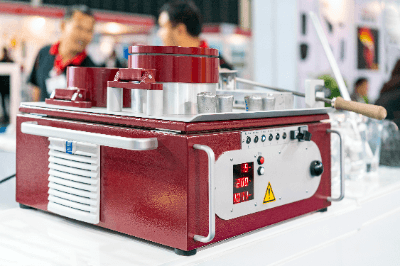What Is a Pinhole Inspection Unit?

A pinhole inspection unit is a machine that inspects packaging materials for pinholes. A pinhole is a hole the size of a needle in a packaging material, or a very small hole on a painted surface of an exterior wall after construction, as if an air bubble has collapsed.
The characteristics of pinholes are that they can be inspected in a nondestructive state, which facilitates re-inspection and pursuit of the cause of defects, and that they can be inspected even when bubbles are present in the product.
There are also pinhole inspection units that can even pinpoint the location of pinholes.
Uses of Pinhole Inspection Units
Pinhole inspection units are used in the manufacture of products that are familiar to us in our daily lives. For example, they are used in the manufacture of food products that contain a lot of liquid, such as jelly, pudding, milk cartons, sausages, etc.
In addition to food products, it is also used in the manufacturing process of household products such as detergent, toothpaste, and shampoo, as well as in the packaging of blood and infusion solutions used in the medical field and in the packaging of eye drops.
However, as will be discussed in more detail below, the principle may not be applicable to packaging materials with low insulation properties and low conductivity contents.
Principle of Pinhole Inspection Units
Pinhole inspection units are designed to determine the presence or absence of pinholes by occurrence or absence of electrical discharges when high voltage is generated in a circuit with electrodes placed at a certain distance from each other.
Normally, the air between two electrodes placed far apart is destroyed when the voltage of the high-voltage generator connected to both electrodes is gradually increased, resulting in a discharge phenomenon that causes the loss of electrical insulation. Plastics used for packaging materials generally have higher insulation properties than air and can withstand stronger voltages (dielectric breakdown voltage) than air can be destroyed, and no electrical discharge phenomenon occurs when a product without pinholes is passed between the electrodes. However, when a product with pinholes is passed through the electrodes, the insulation withstand voltage causes a discharge, which can be detected by the detector by sensing the change in electric current.
For products that are filled with gas to maintain quality, a type of inspection unit that checks for pinholes by detecting gas above a standard concentration is used.
Other Types of Pinhole Inspection Units
There are different types of pinhole inspection units, including discharge-type inspection, which inspects for the presence or absence of electrical discharge due to high voltage, each of which corresponds to the material and characteristics of the item to be inspected.
The main types of pinhole inspection include the following:
- Sheet pinhole inspection unit: Inspects pinholes in paper, film, and other sheet-like samples flowing on the line using a CCD camera (line camera).
- Ultrasonic inspection: Ultrasonic waves are generated when compressed air is injected into a container to be inspected and a pinhole is found. The ultrasonic tone is used to detect pinholes.
- Radiation transmission inspection: Used to inspect pinholes in welds of stainless steel, mild steel pipes, etc. X-rays are used to transmit through the inspected area, and an image is acquired by an X-ray receiver. The image is transmitted through the inspected area using X-rays, and the image is acquired by an X-ray receiver. The image is then processed by an image processor to detect pinholes.
- Airtightness inspection: There are two types of inspections: submersion inspection, which detects pinholes by checking whether bubbles appear on the surface of the water when the container to be inspected is filled with gas and submerged in a water tank, and foam inspection, which uses a foaming liquid that reacts to pinholes and causes bubbles to form.
Pinhole inspection units use cameras and image processing equipment, and automate the process of inserting gas. Pinhole inspection equipment can accurately perform inspections that are limited by visual checks.
Importance of Pinhole Inspection Units
Pinholes can be caused by small impacts on sheet materials such as paper and film, such as when they are caught on an overhang or by friction due to vibration during transportation. In welded metals, pinholes can also be caused by a decrease in gas solubility or gas entrapment.
If pinholes are left unattended, corrosion can start from the pinholes and lead to damage to the object. In the case of containers, the contents may leak out, or conversely, contaminants may enter the container from the outside and affect the contents.
Therefore, even the slightest pinhole must be detected, and pinhole inspection units play an important role.